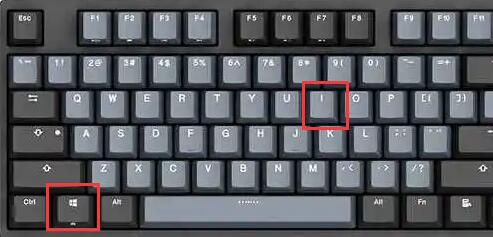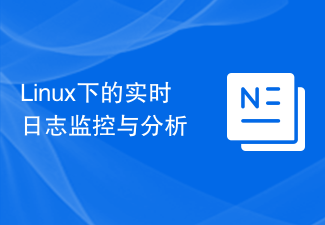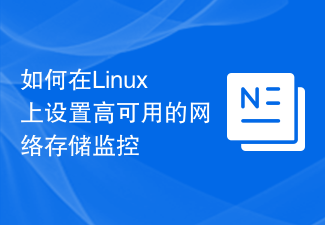 Backend Development
Backend Development PHP Tutorial
PHP Tutorial Monitor and track PHP applications through Docker Compose, Nginx and MariaDB
Monitor and track PHP applications through Docker Compose, Nginx and MariaDB
Monitoring and tracking of PHP applications through Docker Compose, Nginx and MariaDB
With the development of cloud computing and container technology, more and more applications Start deploying in a Docker container. In this case, how to monitor and track applications becomes an important issue. This article will introduce how to monitor and track PHP applications through Docker Compose, Nginx and MariaDB, and give specific code examples.
1. Preparation
Before starting, you need to prepare the following environment:
- Docker: Make sure Docker has been installed and can run normally.
- Docker Compose: Make sure Docker Compose is installed and running properly.
- Nginx: used for proxying and load balancing requests.
- MariaDB: used to store application data.
2. Create a Docker Compose file
Create a file named docker-compose.yml in any directory. The content of the file is as follows:
version: '3'
services:
web:
build: .
ports:
- "80:80"
db:
image: mariadb
environment:
- MYSQL_ROOT_PASSWORD=root
- MYSQL_DATABASE=test_db
volumes:
- ./data:/var/lib/mysqlIn the above In the file, we created two services, one is the web service and the other is the db service. The web service will build an image of the application and map port 80 to the host. The db service uses the mariadb image, specifies the root password and database name, and stores the data in the ./data directory of the host.
3. Create Nginx configuration file
Create a file named nginx.conf in the same directory as docker-compose.yml. The content of the file is as follows:
worker_processes 1;
events {
worker_connections 1024;
}
http {
server {
listen 80;
server_name localhost;
location / {
proxy_pass http://web;
}
}
}In In the above file, we configured Nginx to listen on port 80 and forward the request to the Docker service named web.
4. Create PHP application code
Create a file named index.php in the same directory as docker-compose.yml. The content of the file is as follows:
<?php
$dbhost = 'db';
$dbuser = 'root';
$dbpass = 'root';
$dbname = 'test_db';
$conn = new mysqli($dbhost, $dbuser, $dbpass, $dbname);
if($conn->connect_error) {
die("连接失败:" . $conn->connect_error);
}
echo "连接成功";
$conn->close();
?>In the above file, we connect to the MariaDB database through the mysqli extension and print out a successful connection message.
5. Build and run
Go to the same directory as docker-compose.yml in the terminal and execute the following command to build and run the container:
$ docker-compose build $ docker-compose up -d
Browse Open http://localhost in the server and you should see a successful connection message.
6. Monitoring and Tracking
In order to implement monitoring and tracking of PHP applications, we can use some common tools, such as:
- Prometheus: used Collect and store monitoring metric data.
- Grafana: used to visualize monitoring indicator data.
- Zipkin: Used to track requests in applications.
The specific configuration steps are beyond the scope of this article, but we can refer to the following sample code for configuration.
Add the following services in docker-compose.yml:
prometheus:
image: prom/prometheus
volumes:
- ./prometheus.yml:/etc/prometheus/prometheus.yml
ports:
- "9090:9090"
grafana:
image: grafana/grafana
volumes:
- ./grafana-data:/var/lib/grafana
ports:
- "3000:3000"Create a file named prometheus.yml in the same directory as docker-compose.yml with the following content:
global:
scrape_interval: 15s
scrape_configs:
- job_name: 'php-app'
static_configs:
- targets: ['web:80']In the above file, we configured Prometheus to regularly collect indicator data on the web service.
Rebuild and run the container by executing the following commands to start Prometheus and Grafana:
$ docker-compose build $ docker-compose up -d
Open http://localhost:3000 in the browser, use the default username and password ( admin/admin) to log in to Grafana, then configure the Prometheus data source and create a dashboard to visualize monitoring metric data.
As for the configuration of Zipkin, you can refer to the official documentation and related sample codes to complete it.
Summary
Through Docker Compose, Nginx and MariaDB, we can easily build a monitoring and tracking environment for PHP applications. By configuring Prometheus and Grafana, you can collect and visualize application monitoring indicator data. By configuring Zipkin, you can track requests in your application. The above is a simple example, you can customize and adjust it according to actual needs and environment. Hope this article helps you!
The above is the detailed content of Monitor and track PHP applications through Docker Compose, Nginx and MariaDB. For more information, please follow other related articles on the PHP Chinese website!
 如何在FastAPI中实现请求日志记录和监控Jul 30, 2023 am 08:29 AM
如何在FastAPI中实现请求日志记录和监控Jul 30, 2023 am 08:29 AM如何在FastAPI中实现请求日志记录和监控引言:FastAPI是一个基于Python3.7+的高性能Web框架,它提供了许多强大的功能和特性,包括自动化的请求和响应模型验证、安全性、性能优化等。在实际开发中,我们经常需要在应用程序中记录请求日志以便进行排错和监控分析。本文将介绍如何在FastAPI中实现请求日志记录和监控,并提供相应的代码示例。一、安装依
 win10监控摄像头打开照片的方法Jul 10, 2023 pm 09:41 PM
win10监控摄像头打开照片的方法Jul 10, 2023 pm 09:41 PM如果我们手头没有手机,只有电脑,但我们必须拍照,我们可以使用电脑内置的监控摄像头拍照,那么如何打开win10监控摄像头,事实上,我们只需要下载一个相机应用程序。打开win10监控摄像头的具体方法。win10监控摄像头打开照片的方法:1.首先,盘快捷键Win+i打开设置。2.打开后,进入个人隐私设置。3.然后在相机手机权限下打开访问限制。4.打开后,您只需打开相机应用软件。(如果没有,可以去微软店下载一个)5.打开后,如果计算机内置监控摄像头或组装了外部监控摄像头,则可以拍照。(因为人们没有安装摄
 Linux下的实时日志监控与分析Jul 29, 2023 am 08:06 AM
Linux下的实时日志监控与分析Jul 29, 2023 am 08:06 AMLinux下的实时日志监控与分析在日常的系统管理和故障排查中,日志是一个非常重要的数据来源。通过对系统日志的实时监控和分析,我们可以及时发现异常情况并进行相应的处理。本文将介绍Linux下如何进行实时日志监控和分析,并提供相应的代码示例。一、实时日志监控在Linux下,最常用的日志系统是rsyslog。通过配置rsyslog,我们可以实现将不同应用程序的日志
 如何使用Golang实现Web应用程序监控Jun 24, 2023 am 09:00 AM
如何使用Golang实现Web应用程序监控Jun 24, 2023 am 09:00 AM在当今的互联网时代,Web应用程序的高效稳定运行是非常重要的。然而,应用程序可能会出现故障或崩溃,影响用户体验。为了确保应用程序的正常运行,我们需要对其进行监控。本文将探讨如何使用Golang实现Web应用程序监控。一、Golang的Web应用程序监控工具Golang拥有非常适合Web应用程序监控的工具。其中最流行的就是Prometheus。Promethe
 Nginx性能监控与安全分析辅助工具Jun 10, 2023 pm 02:41 PM
Nginx性能监控与安全分析辅助工具Jun 10, 2023 pm 02:41 PM随着互联网的发展,web应用程序的性能监控以及安全分析越来越受到重视。nginx作为一款高性能的Web服务器和反向代理工具,其在性能监控和安全分析方面也受到广泛的关注和应用。本文将介绍一些Nginx性能监控和安全分析的辅助工具。Nginx性能监控工具NginxAmplifyNginxAmplify是Nginx公司推出的一款性能监控工具。该工具可以
 基于go-zero实现微服务调用链监控Jun 23, 2023 am 09:53 AM
基于go-zero实现微服务调用链监控Jun 23, 2023 am 09:53 AM随着微服务架构的广泛应用,调用链监控已经成为了保障微服务健康运行的重要手段。而基于go-zero框架实现微服务调用链监控,则是更加高效可靠的实现方式。一、调用链监控的基本概念微服务架构中,一个请求可能经过多个微服务组件的调用,这些调用形成了一条调用链。而一旦某一个环节出现问题,整个服务甚至整个系统都有可能受到影响。因此,调用链监控这个技术,就是通过记录整条调
 Nginx监控实时状态配置,实时查看网站运行Jul 04, 2023 pm 05:18 PM
Nginx监控实时状态配置,实时查看网站运行Jul 04, 2023 pm 05:18 PMNginx监控实时状态配置,实时查看网站运行引言:Nginx是一款非常流行的反向代理服务器,其高性能和高并发能力使得它成为了许多网站的首选。为了保证网站的稳定运行,我们需要时刻监控Nginx的运行状态。本篇文章将介绍如何配置Nginx实时状态监控,并通过示例代码来让读者更好地理解。一、安装Nginx状态监控模块要实现Nginx的实时状态监控,需要在Nginx
 如何在Linux上设置高可用的网络存储监控Jul 07, 2023 pm 12:07 PM
如何在Linux上设置高可用的网络存储监控Jul 07, 2023 pm 12:07 PM如何在Linux上设置高可用的网络存储监控在现代的IT环境中,网络存储是一个关键组件,用于存储和管理海量的数据。为了确保数据的可靠性和高可用性,对网络存储的监控和故障恢复是非常重要的。本文将介绍如何在Linux上设置高可用的网络存储监控,并提供代码示例。第一步:安装监控工具在Linux上,我们可以使用一个开源的监控工具来监控网络存储,比如Nagios。首先,


Hot AI Tools

Undresser.AI Undress
AI-powered app for creating realistic nude photos

AI Clothes Remover
Online AI tool for removing clothes from photos.

Undress AI Tool
Undress images for free

Clothoff.io
AI clothes remover

AI Hentai Generator
Generate AI Hentai for free.

Hot Article

Hot Tools

Zend Studio 13.0.1
Powerful PHP integrated development environment

EditPlus Chinese cracked version
Small size, syntax highlighting, does not support code prompt function

Dreamweaver Mac version
Visual web development tools

Atom editor mac version download
The most popular open source editor

mPDF
mPDF is a PHP library that can generate PDF files from UTF-8 encoded HTML. The original author, Ian Back, wrote mPDF to output PDF files "on the fly" from his website and handle different languages. It is slower than original scripts like HTML2FPDF and produces larger files when using Unicode fonts, but supports CSS styles etc. and has a lot of enhancements. Supports almost all languages, including RTL (Arabic and Hebrew) and CJK (Chinese, Japanese and Korean). Supports nested block-level elements (such as P, DIV),





